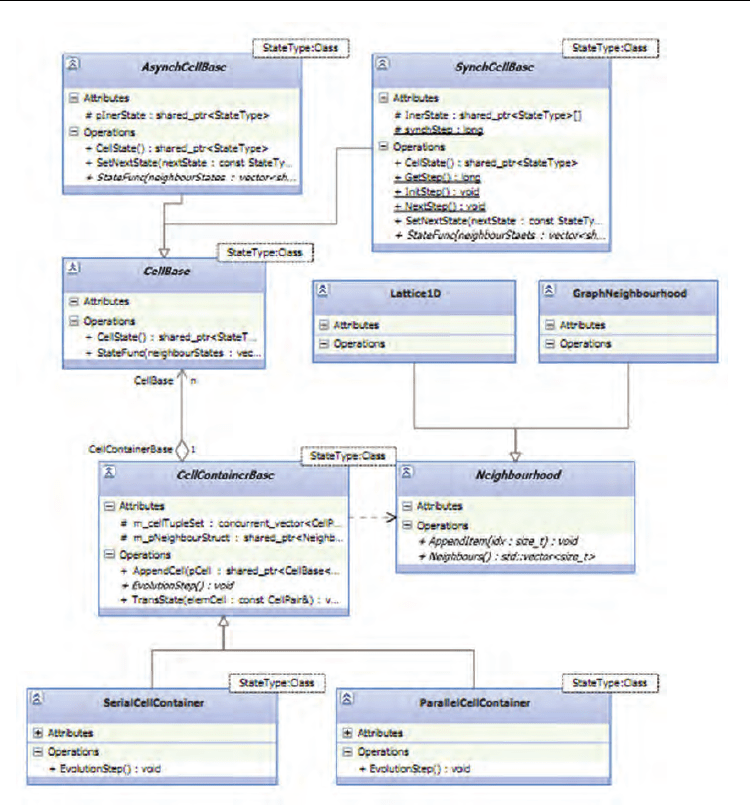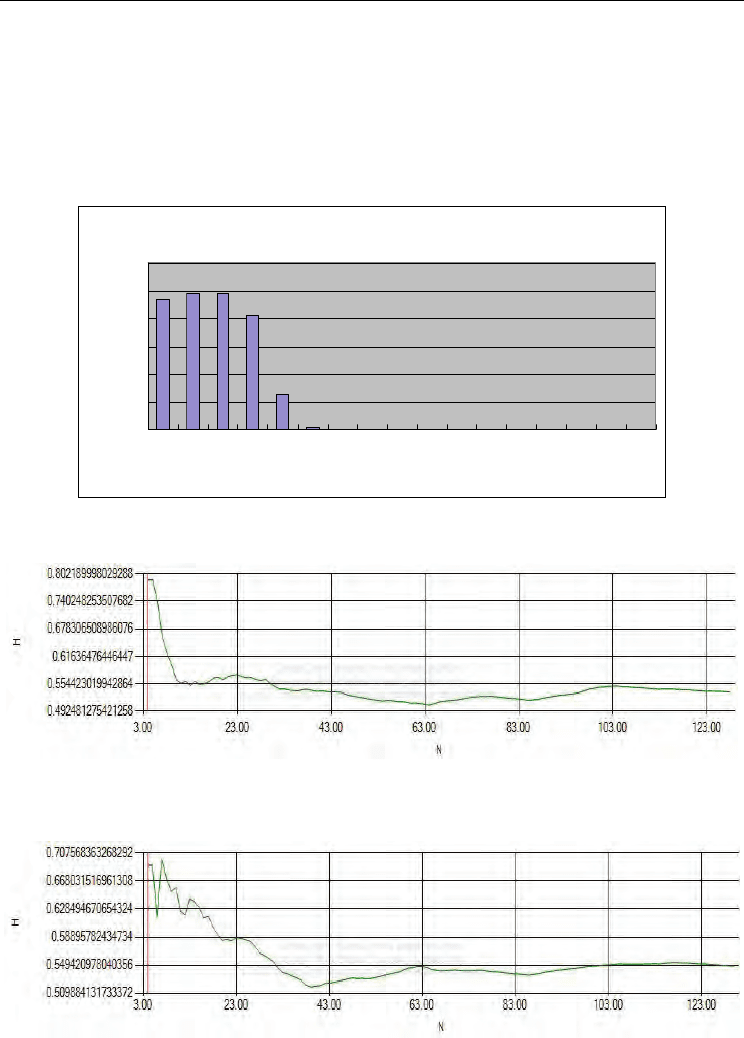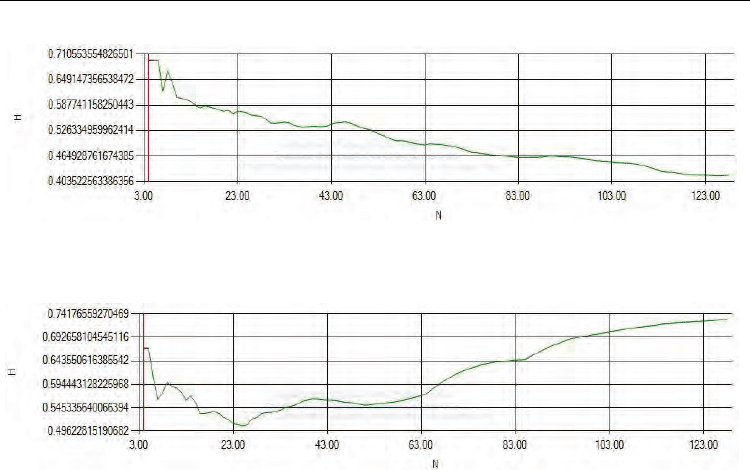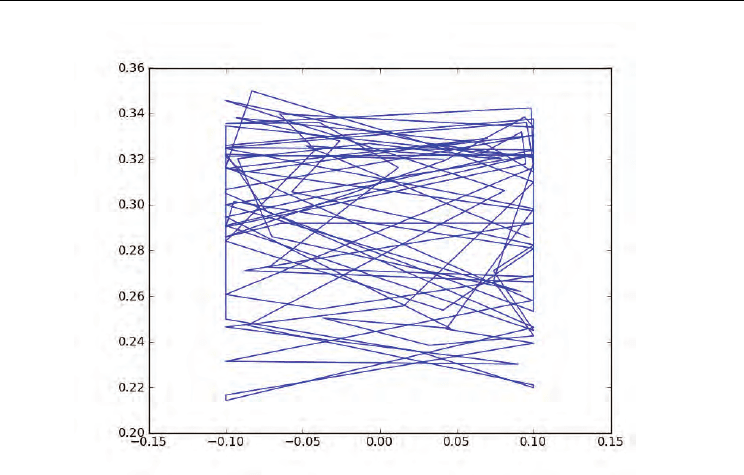Salcido A. (ed.) Cellular Automata - Simplicity Behind Complexity
Подождите немного. Документ загружается.


Cellular Automata based Artificial Financial Market
367
insteads the original Z
d
, which means the space of cellular automata dosen't have to be
Euclid space. It could be a network or graph structure. Accordingly the N in the cellular
automata may follow the graph's neighbourhood definition. Further more, the N dosen't
have to be stable. : N→N is the neighbourhood transformation function, which can change
the neighbourhood in every evolution step of the cellular automata. P stands for the public
information. Accordingly the state transition function becomes
δ
: P,S
n+1
→S.
Although we extended the definition from classic cellular automata, we still kept its
essential features. The new kinds of cellular automata are still time-space discrete system.
Each cell decides its state in next step according to the states of neighbours and itself in
current step. The macrodynamics of cellular automata is the emergence of masses of cells'
adaptive behaviours. The classic cellular automata could be regarded as an instance of the
new definition. Because the cells could be heterogeneous, a cellular automaton under new
definition could also be a multi-agent system.
New definition of cellular automata gives us a foundation to define a cellular automata based
artificial financial market. Because there could be many artificial financial markets under
different assumptions, we just define the general part of them. In a cellular automata based
artificial financial market, each cell represents an investor. Z in the formula (4) is the set of
cells. In cellular automata based artificial financial market, the finite states set S is a 6-tuple:
(,,,,,)
ufuf
SCCSSQE
=
(5)
C
u
and C
f
stand for usable and frozen cash respectively. S
u
and S
f
are usable and frozen stock
respectively. Q is the set of orders which have been quoted to exchange house but have not
been completed or canceled yet. Each order includes direction (ask or bid), price and
amount. E, which valued rise, fall, or keeping, is the price prediction of an investor. C
p
is the
total property of an investor. Given P as current stock price, C
p
can be expressed as follows:
(
)
p
u
f
u
f
CCCPSS=++ +
(6)
Maximization of
C
p
is the only goal for all investors.
N is the neighborhood in cellular automata. In this ASM, N is a directed graph. When Cell
i
is
making a prediction, a directed edge
<i, j> between Cell
i
and Cell
j
exists only if the S.E value
of
Cell
j
can affect the S.E value of Cell
i
. In this condition, Cell
j
is defined as a neighbor of Cell
i
.
The neighbour relationship between these two cells is not self reciprocal.
In the cellular automata based artificial financial market, public information includes
trading data, public financial policy, such as risk free rate, and company news, such as
financial reports and bonus. As the definition of cellular automata, public information is
represented by
P. The state transition function decide a cell's state according to the public
information and the states of the cell self and the neighbours. So is defined as:
1
:,
n
PS S
δ
+
→ (7)
The neighborhood transition function is:
:
NN
σ
→ (8)
is the variance of the dependency relationship between cells. Based on different
assumptions, methods to rebuild the dependency networks can be different.
would be
performed after each trading day.

Cellular Automata - Simplicity Behind Complexity
368
Once we gave the extended definition of cellular automata specific meaning, we defined a
cellular automata based artificial financial market. We try our best to abstract the essential of
the capital market. We emphasize the heterogeneous individual behaviours, as well as the
complex information spread in the market. We believe the information is the decisive factor
for a predictive system. The Emergence-Artificial Financial Market Framework, which
would be introduced later, is a realization of the cellular automata based artificial financial
market.
5. The emergence-artificial financial market framework
Now we can build artificial financial market models under above definition. As we know,
the target of artificial financial market is to find out the relationship between
macrodynamics and microstructure of the capital market, and verify the financial theories
which are based on different assumptions. These assumptions are focus on the investors'
behaviours and the spread of information. Other components of the capital market are
stable and clear. So, we built a framework, realized the common parts of the capital markets
in it, and defined the interfaces of the heterogeneous investors and informations. Because
the complex macrodynamics could be regarded as the emergence of the adaptive behaviours
of individuals, we named the framework "The Emergence-Artificial Financial Market
Framework (E-AFM)".
5.1 The structure of E-AFM
As we defined in section 4, an E-AFM is a cellular automata based artificial market, so, first, we
realized a cellular automata library under the extended definition. Then we realized E-AFM as
a template instantiation of the cellular automata library. All these frameworks are realized in
C++ language, in order to utilize its generic programming mode and parallel technology.
The basic starting point of the cellular automata library is abstraction of the data type of the
cell state (personal infermation) , and public information. That's why we use parameterized
type feature of C++ template. The base classes of cell, cells' container, neighbourhood, are
provided in the library. The base classes of cell and cells' container are both template classes.
The template parameters are the abstract data types of cell state and public information. The
template parameter StateType is the data type of the cells states. Users can define it
according to their needs. In the CellBase<StateType> class, state transition function is
declared as a pure virtual function, any class, which derived from CellBase<StateType>,
should overwrite the state transition function in its own rule. Two derived classes of
CellBase<StateType> were provided in this library, one is for synchronous cellular
automata, and another is for asynchronous cellular automata. When we realize a cellular
automaton, we just need to define the data type of personal and public information, design a
class derived from class SynchCellBase<StateType> or class AsynchCellBase<StateType>,
and provide relevant state transition function.
In the cellular automata library, all cells are managed by cell container classes. The design
targets of the cell container include following aspects. Firstly, the cell container should
provide one or more kinds of traversal methods to access all cells in the cellular automaton.
Secondly the cells’ random access should be supported, because we can’t assume the
structure of users’ cellular automata, and we need to access a cell through its neighbors.
Thirdly, the neighborhood of the cellular automata should have an inner expression in the
container. That means, when we access a cell, it is required to get the cell’s neighbors

Cellular Automata based Artificial Financial Market
369
directly. Lastly, both serial and parallel accesses must be supported by the container. In
detail, when different threads access different cells without mutex at the same time, the
container should be thread safe. When different threads access the same cell at the same
time, a mutex would be provided.
In our cellular automata library, the solution to satisfy the requirement of concurrency is
class concurrent_vector which is provided in Microsoft Concurrency Runtime technology. If
we use this library to build a cellular automaton model, all container classes should derive
from class CellContainerBase<StateType>, which uses a thread safe container class
concurrent_vector to store cells. So we can access any cell randomly by its index. The class
CellContainerBase<StateType> has a member pointer, which points to a derived class of
class Neighborhood. Neighborhood class declared two basic abstract functions. The function
AppendItem is used to add a new cell's index into the relationship structure. The function
Neighbors is required to return a cell's neighbors’ index. The derived classes of neighborhood
are required to realize the two functions. The purpose of adopting index to manage cells'
neighborhood is to separate the design of container class and neighborhood class. Two
derived classes of CellContainerBase<StateType> are provided to perform the evolution of
the cellular automata in serial or parallel way.
As discussed above, an artificial financial market would be regarded as a cellular automaton
model. So, E-AFM, as a framework, realized the main parts of this kind of cellular automata.
The realized parts include the investment process of each investor (cell); the interaction way
with cells; the basic mechanism of the artificial financial market; the definitions of evolution
step and trading day; the account management etc. But the basic assumptions to the capital
market are left to model designers. For example, model designers can define the data type of
the public or private information, decide the structure and the evolution of neighborhood,
design the behavior of investors, and choose the price formation mechanism of the capital
market, such as order-driven or quote-driven rule.
The E-AFM is a template instantiation of the cellular automata library. As discussed above,
the state type of an investor has been defined clearly in formula(5). The classes which are
related to cash account, position account, trading orders, and investor's attitude are
provided in E-AFM as cell state. So we can instant the template classes of the cellular
automata library, and provide their derived class in E-AFM. SimInvestorBase class is
derived from CellBase<StateType> class. It provided functionality to manage cell state itself,
but it is still an abstract class, because the investment process are left to users to realize.
There are also some classes derived from neighbourhood class provided in E-AFM. These
neighbourhood classes can change their structures after a trading day. Especially some
neighborhood transition functions are related with individuals' state. There are other
components in E-AFM, which provide stable functionalities such as account management,
exchange, quoted order management, and pricing mechanism etc. It is not necessary to
derive them usually.
When we simulate the artificial financial market, we are performing the evolution of the
cellular automata. Utilizing the Concurrent Runtime technology, the simulation could be
parallel. The benefits of parallel simulation are not only higher performance. It is more
important that the concurrent evolution is more close to reality. A trading day was defined
as an evolution with several steps in the E-AFM. After a trading day, the artificial financial
market would be closed, and the accounts' settlement would be performed. The
neighbourhood of the cellular automata could be rebuilt too. One simulation of an E-AFM
instance could include hundreds of trading days.

Cellular Automata - Simplicity Behind Complexity
370
Fig. 2. Static Structure of Cellular Automata Library
5.2 Analysis tools in E-AFM
After a simulation finished, trading data would be produced as real capital market. Some
tools are provided in E-AFM to analysis the macrodynamics and microstructure of cellular
automata based artificial markets. Some of these tools can also be used to analysis trading
data of real capital market.
One of the analysis tools is the Hurst exponent which was introduced into financial time
series analysis first by Mandelbrot. Mandelbrot consider the Hurst exponent is better than
variance analysis, spectral analysis, and autocorrelation. Hurst exponent is mainly used to
estimate the long term memory of time series. R/S analysis (Rescaled Range Analysis)

Cellular Automata based Artificial Financial Market
371
(Hurst, 1951) is the most classic estimation method of Hurst exponent. Edgar E. Peters used
R/S analysis to find the fractal feature of financial time series, and built the Fractal Market
Hypothesis (FMH). R/S analysis is also provided in E-AFM.
We have a time series, which length is
T. First, we should divided the time series into N
adjacent v-length sub-periods, and N*v=T. Each sub-period is recorded as I
n
, n =1,...,N. Each
element in
I
n
is recorded as r
t,n
, t= 1,2, ...,v. M
n
is the arithmetic mean value of I
n
. We can
calculate the the accululated deviation
X
t,n
from the mean using following equation:
,
1
t
tn u n
u
XXM
=
=−
∑
(9)
Let:
(
)
,,
max( ) min( )
ntntn
RX X=−
(10)
R
n
is called range of I
n
. Let S is the standard deviation of the I
n
. Then the Rescaled Range is
defined as:
()
()
H
nn
ER S aN= as N→∞. (11)
or:
()
(
)
() ()
log log log
nn
ER S H N a=+ (12)
The slope H is the Hurst exponent. It can be estimated by least square method or other
methods.
One of E-AFM's tasks is to find how does the microstructure of the capital market cause
complexity of macrodynamics. For example, the structure of neigbourhood graph can
influence the spread of non-public information in the capital market. We use the degree
distribution to measure the complexity of the networks, and use the clustering coefficient to
measure the dependency level within the investors. The clustering coefficient
γ
v
of a vertex v
in a graph can be defined as:
(
)
2
v
v
v
E
k
γ
Γ
=
⎛⎞
⎜⎟
⎝⎠
(13)
Where
Γ
v
is the neighbourhood of vertex v, and |E(Γ
v
) |is the number of edges in the
neighbourhood.
2
v
k
⎛⎞
⎜⎟
⎝⎠
is the maximum number of possible edges in the neighbourhood.
There are still many other methods could be used to measure the time-space complexity of
the artificial financial market. Due to space limitations, we don't discuss them individually.
6. Dynamic analysis of an Artificial Financial Market
In the last part of this chapter, we'd like to show the readers an example artificial financial
market which is based on E-AFM, and analysis the results of simulation. The assumptions of
this artificial financial market are not complete enough to proclaim a new capital market

Cellular Automata - Simplicity Behind Complexity
372
theory. But it can show us that the cellular automata based artificial financial market could
be an effective tool to simulate the process of self-organization in the capital market. And it
can also show how does the structure of the social network influence the spread of
information and then influence the price fluctuation.
In this artificial financial market, we assume that an investor's behaviour can be divided into
prediction stage and investment stage. In the prediction stage, the investor predicts the
direction future market price (tuple
E in equation 5) according to the public and non-public
information. The public information is the technical analysis on history trading data, such as
moving average convergence/divergence index (MACD). The non-public information is the
collection of neighbours' attitudes. Each investor has a weight number
δ
i
decides the
different influence of the public and non-public information on the investor's judgement.
The prediction is the base of the investment stage and the non-public information which can
be visited by neighbours. Once the prediction is made, the investor would send orders to
exchange, according to its condition of assets (
S in equation 5). Both the prediction and
investment stage are parts of the investor's state transition function. Prediction stage is more
important, because it's the stage of information processing. The heterogeneity of the
individuals is also reflected in the prediction stage.
The neighbourhood of the cellular automata is defined as a social network. The initial
network is a random graph. However, after each trading day, the network would be rebuilt.
An individual's history in-degree and its assets condition ranking are two factors
influencing its in-degree in next network. There is a weight number
ω to accommodate the
importance of the two factors. The pricing mechanism in this model adopts the order-driven
Electronic Communications Networks (ECNs) Trading mode.
There are 2 critical control parameters in this artificial financial market,
ω and δ
i
. ω decides
the weight coefficient between historical stickiness and profit orientation when rebuilding
the dependency network.
δ
i
decides the weight coefficient between technical analysis and
herd psychology in a cell's prediction stage. The simulation results show that the the co-
effect of the two key factors caused the different structures of the neighbourhood, and
various features of price fluctuation.
When the individuals' history in-degree plays the main role in rebuilding the neighbourhood
network, the degree distribution is shown in Figure 3. After enough trading days, the
clustering coefficient is close to 0.5. That means the interaction is active under this condition.
degree distribution
0
2
4
6
8
10
12
14
16
1 2 3 4 5 6 7 8 9 10 11 12 13 14 15 16 17 18
degree 10
Agents
Fig. 3. Degree Distribution of History Degree Ranking Hurt Behaviour

Cellular Automata based Artificial Financial Market
373
On the other hand, when the individuals' assets condition ranking plays the main role in
rebuilding the neighbourhood network, the degree distribution is shown in Figure 4. And the
clustering coefficient is close to 0.3. The investors rely more on the judgement of themselves.
Another problem is whether the public or non-public information plays the main role when
individuals predict the market price. We simulated the two assumptions both. Combining
with the factor of neighbourhood structure, we got four simulation results. We estamited
their Hurst exponent using R/S analysis, which are showed in Fig 5, Fig 6, Fig 7, Fig 8.
degree distribution
0
10
20
30
40
50
60
1234567891011121314151617
degree 10
Agents
Fig. 4. Degree Distribution of Assets Ranking Hurt Behaviour
Fig. 5. Assets Ranking Hurt Behaviour & Public information
Fig. 6. History Degree Ranking Hurt Behaviour & Public information

Cellular Automata - Simplicity Behind Complexity
374
Fig. 7. Assets Ranking Ranking Hurt Behaviour & Non-Public information
Fig. 8. History Degree Ranking Hurt Behaviour & Non-Public information
It is noticed that the homogeneity of investors is weak when public information plays the
primary role in prediction. At this time, especially when assets ranking determines the
neighbourhood structure, the Hurst exponent is close to 0.5. This means the volatility of
market prices follows Random Walk, just like the hypothesis of classic theory.
When non-public information plays the primary role in prediction., the market mainly
consists of herd behavior investors, and the transmission dynamic structure plays the
decisive role in determining the durative or anti-durative of the price movement. When
assets ranking determine the neighbourhood strucure, the Hurst exponent is close to 0.4
(Figure 7). The remarkable anti-durative of the price movement indicates the collapse of
market. When history degree ranking determine the neighbourhood strucure, the historical
stickiness causes durative of the price movement, and the Hurst exponent is close to 0.74.
We can also compare the yield rate and the Hurst exponent. As showed in Fig 9, the X-axis
is the yield rate and the Y-axis is the Hurst exponent, when Hurst exponent stands low level,
yield rate is just a fluctuation around zero. When Hurst exponent is less than 0.5, the system
has the feature of anti-persistence, reversals of the price movement would appear
frequently.
The simulation result presented above shows that the transmission dynamic structure is of
critical importance to the prices movement in a market full of herd behavior investors.
Because of the susceptibility of the herd behavior investor, the transmission of the market
information could enhance the homogeneity of the investors. If there are some historical
sticking authorities trusted by most herd behavior investors in this kind of market, the
durative prices movement would appear. If the sticking trust disappears, the herd behavior
investor will fall into panic, and the market collapse will come out. It is interesting that both
positive and opposite deviation of Hurst exponent from 0.5 is caused by the homogeneity of

Cellular Automata based Artificial Financial Market
375
Fig. 9. Phase Diagram of yield rate and the Hurst exponent.
investor structure. The durative or anti-durative of the price movement just depends on
whether the information source is keeping changing. In a developed and mature market,
however, because there are large amounts of heterogeneous investors, the effect of the
transmission dynamic structure is relatively weak.
7. Conclusion and future works
When we build a model for the capital market, tt is difficult to include all essential factors
into considering. But we can believe the heterogeneous investors' response to the
information spreaded in the market is fundamental motive power of the macrodynamics of
the capital market. Investors response to the information and produce information at the
same time. The capital market is a kind of self-feedback system. The self-feedback procedure
is so complex, and the microstructure formed by the individuals' adaptive behaviour play
the primary role. The cellular automata based artificial financial market provided a
possibility to describe these factors, and their interaction rules. The self-organization process
could be simulated in it. The macrodynamics of the artificial financial market and real
capital market can be compared.
However, we must recognize that the cellular automata based artificial market is not mature
enough to build a new capital market theory. What is the key feature of the microstructure
inside the investors? How can we measure it? There is still no perfect answer. We just have
some ideas to do further research. For example, cluster coefficients of network may be
related with volatility feature of price; Investors following various behavior rules, may have
different average yield rates. But there is still no remarkable result supporting these
assumptions.

Cellular Automata - Simplicity Behind Complexity
376
In the future, the cellular automata based artificial financial market should be extended to
describe market factors more particularly. The evolution rule should be more valid. More
researches should be focus on the category, form, and spread way of the information. And
we should consider more effective way to measure the complexity of the microstructure
within the individuals.
8. References
Norman Ehrentreich.(2008) Agent-based modeling: the Santa Fe Institute artificial stock
market model revisited, Lecture Notes in Economics and Mathematical Systems,
vol 602, Springer Berlin Heidelberg pp.91-112
Yi-ming Wei, Shang-jun Ying, Ying Fan and Bing-Hong Wang.(2003) The cellular automaton
model of investment behavior in the stock market, Physica A: Statistical Mechanics
and its Applications, Volume 325, Issues 3-4, Pages 507-516
Ying Fan, Shang-Jun Ying, Bing-Hong Wang, Yi-Ming Wei.(2008) The effect of investor
psychology on the complexity of stock market: An analysis based on cellular
automaton model, Computers & Industrial Engineering.
Edgar E.peters. (1996) Chaos and Order in the Capital Markets: A New View of Cycles,
Prices, and Market Volatility, Wiley; 2 edition.
Edgar E.peters.(1994) Fractal Market Analysis: Applying Chaos Theory to Investment and
Economics, Wiley; 1 edition.
Jesse Nochella.(2006) Cellular Automata on Networks, NKS 2006 Wolfram Science
Conference
M.A. S
ánchez Graneroa, J.E. Trinidad Segoviab, and J. García Pérez.(2008) Some comments
on Hurst exponent and the long memory processes on capital markets, Physica A:
Statistical Mechanics and its Applications, Volume 387, Issue 22, Pages 5543-5551
Daron Acemoglua, Asuman Ozdaglarb, Ali ParandehGheibi. (2010) Spread of
(mis)information in social networks, Games and Economic Behavior.
Andrea Consiglio, Annalisa Russino.(June 2007) “How does learning affect market
liquidity? A simulation analysis of a double-auction financial market with portfolio
traders”, Journal of Economic Dynamics and Control, Volume 31, Issue 6, pp. 1910-
1937
